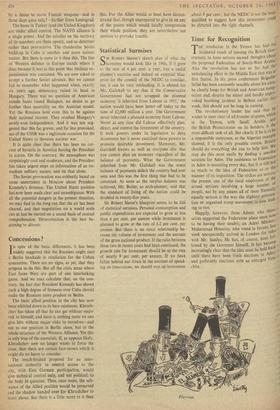Statistical Surmises
SIR ROBERT SHONE's sketch plan of what the economy would look like in 1966, if it grew a: the rate of 4 per cent. a year, was a useful planner's exercise and indeed an essential blue- print for the council of the NEDC to consider, but it can be very misleading. It is absurd for Mr. Gaitskell to say that if the Conservative Government had not scrapped the planned economy 'it inherited from Labour in 1951,' the nation would have been better off today to the tune of £2,000 million a year. The Government never inherited a planned economy from Labour. Never at any time did Labour effectively plan, direct, and control the investment of the country. It took powers under its legislation to deny investment but it never exercised these powers to promote desirable investment. Moreover, Mr. Gaitskell knows as well as everyone else that you cannot plan an economy regardless of the balance of payments. What the Government inherited from Mr. Gaitskell was the worst balance of payments deficit the country had ever seen and this was the first thing that had to be corrected. As soon as the surplus balance was achieved, Mr. Butler, as arch-planner, said that the standard of living of the nation could be doubled in twenty-five years.
Sir Robert Shone's blueprint seems to be full of statistical surmises. Personal consumption and public expenditures are expected to grow at less than 4 per cent. per annum while investment is planned to grow at the rate of 6.2 per cent. per annum. But there is no exact relationship be- tween the volume of investment and the amount of the gross national product. If the ratio between these two in recent years had been continued, the growth rate for investment should be at the rate of nearly 9 per cent. per annum. If we have fallen behind our rivals in the amount of spend- ing on innovations, we should step up investment about 9 per cent.; but the NEDC is not the body qualified to suggest how this investment could be directed into the right channels.














































 Previous page
Previous page